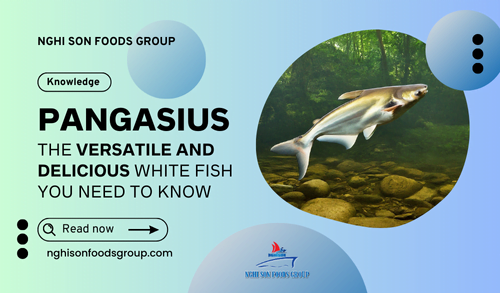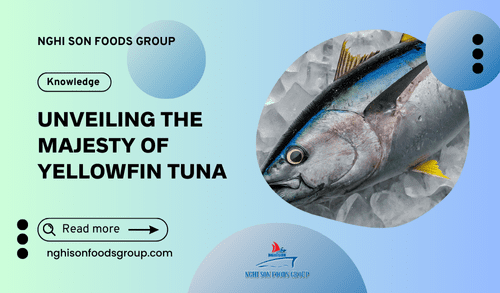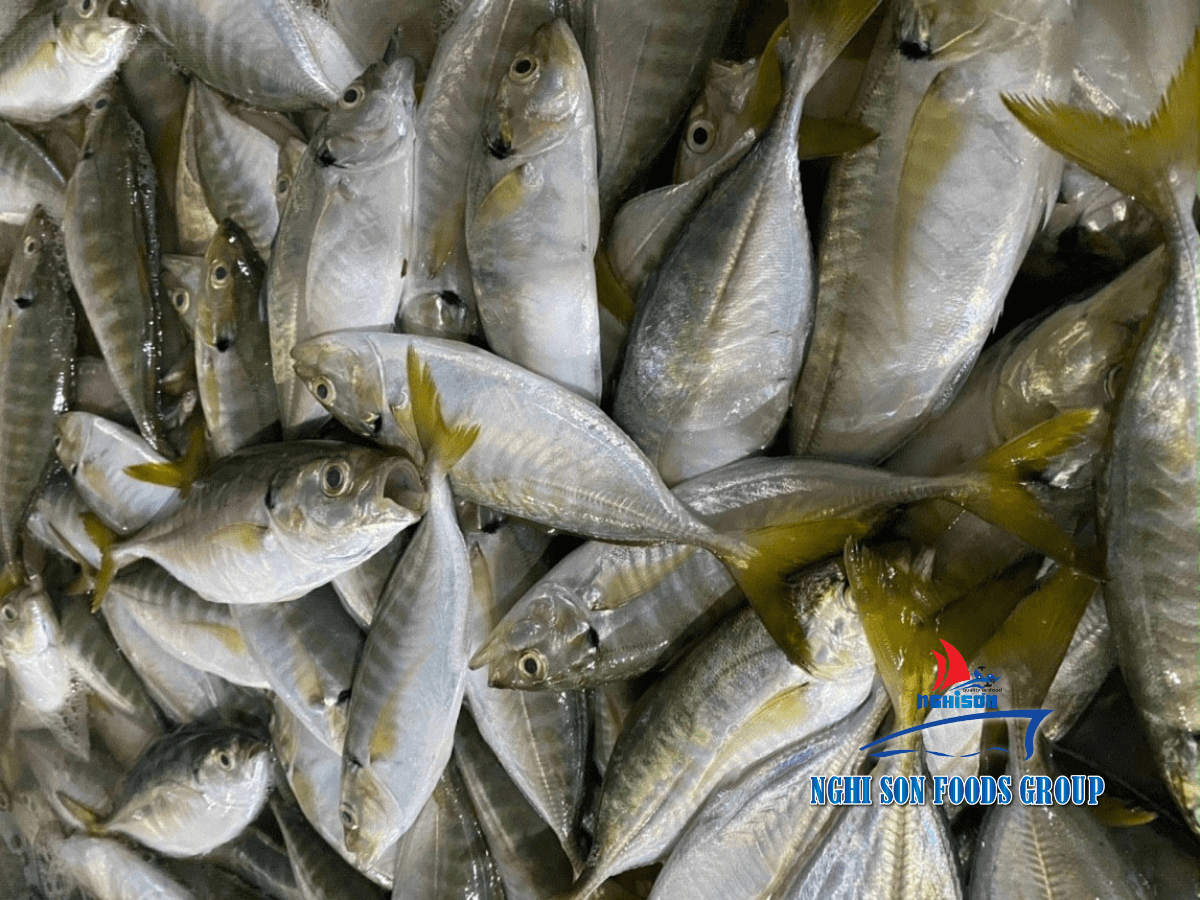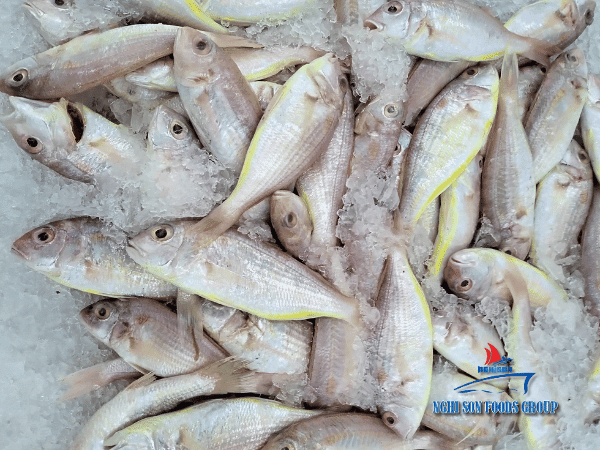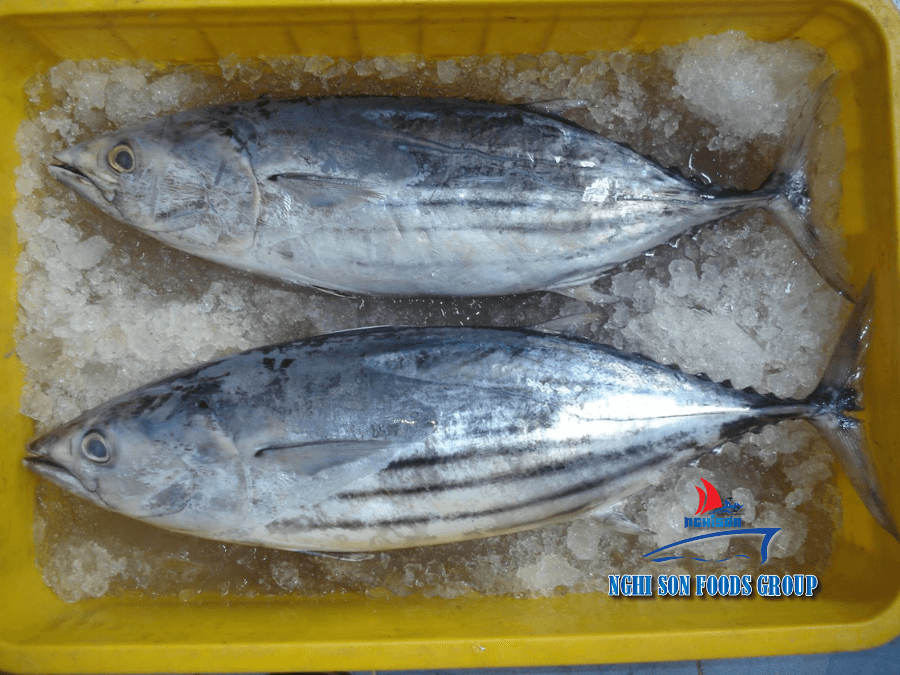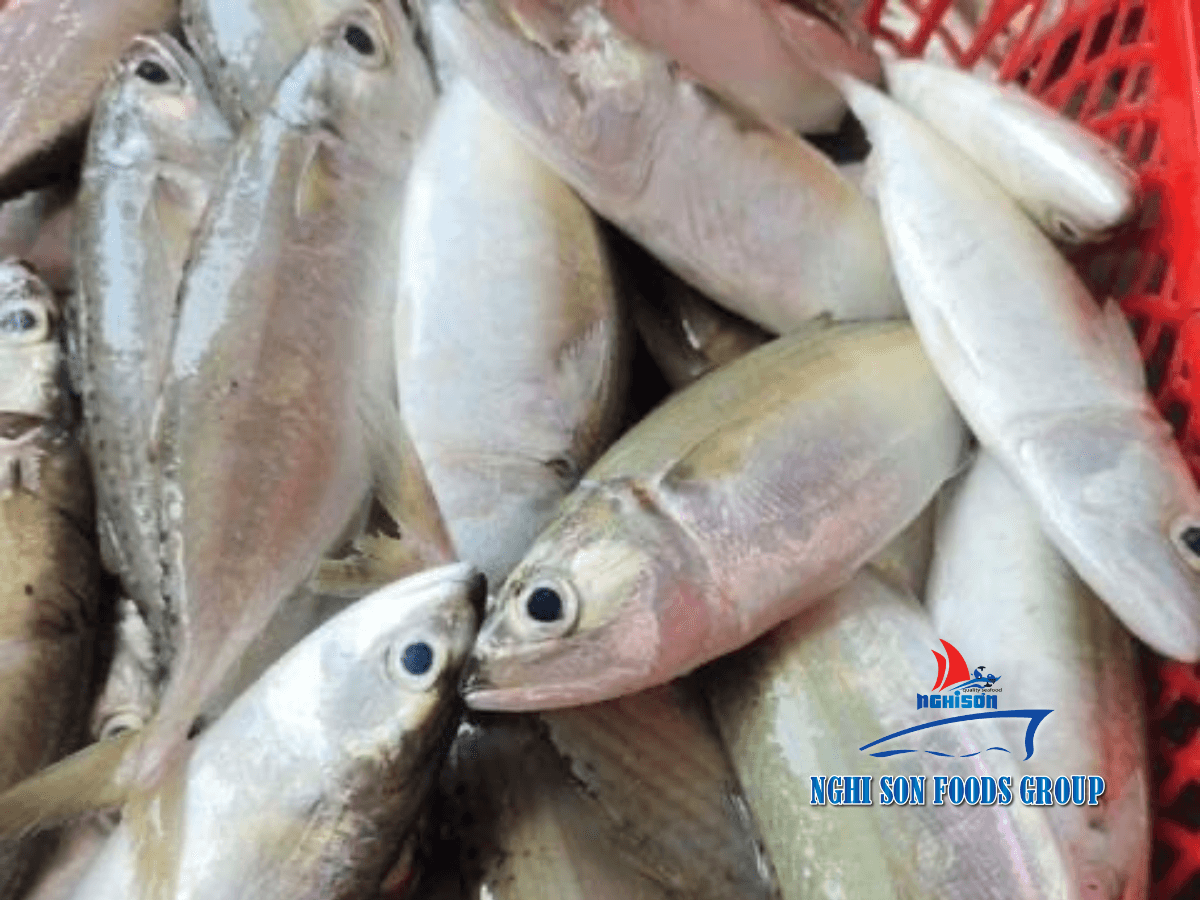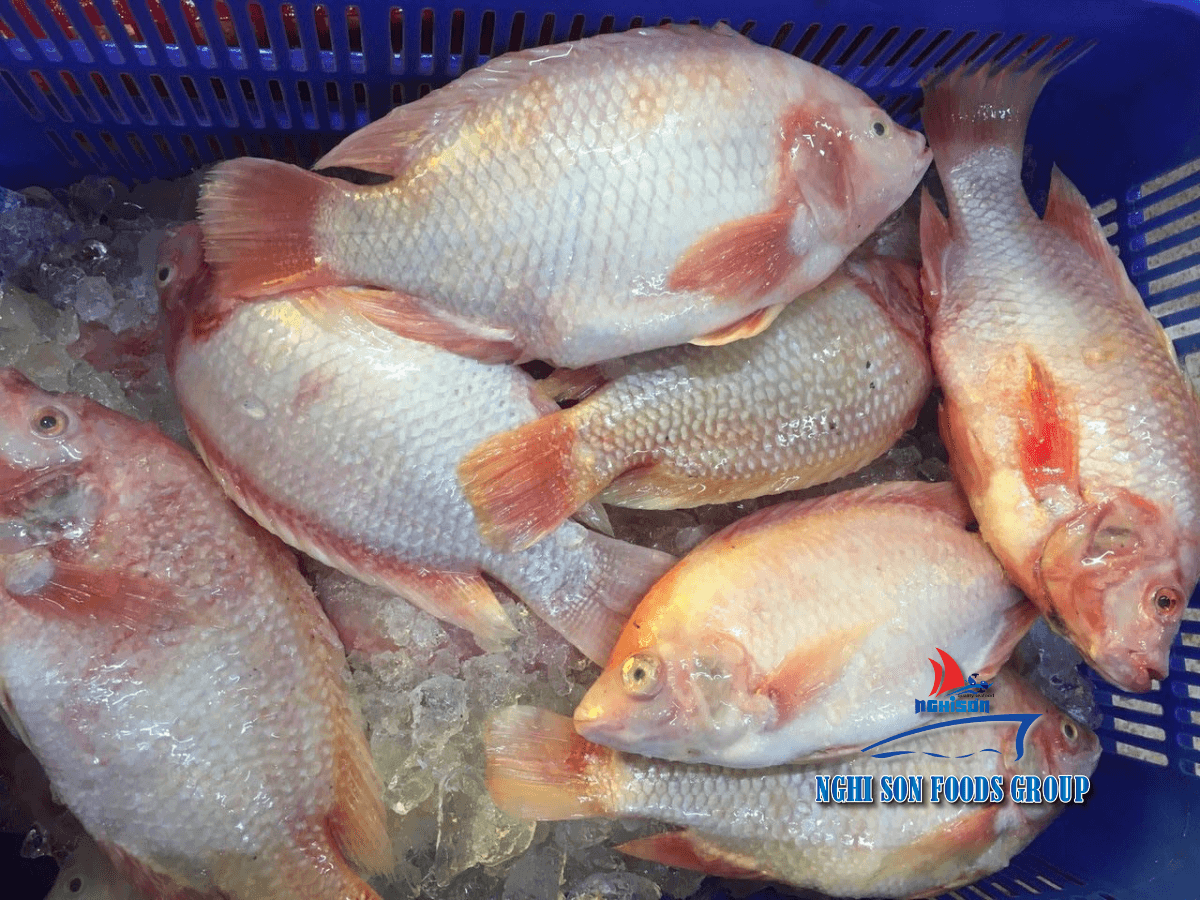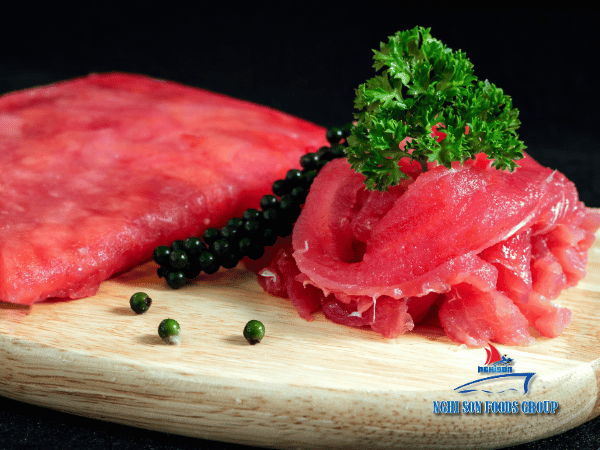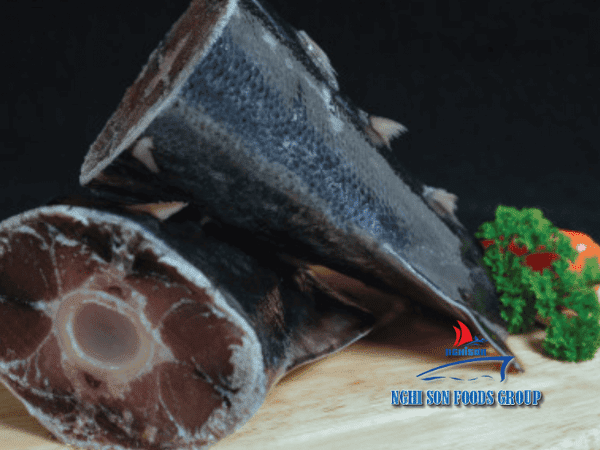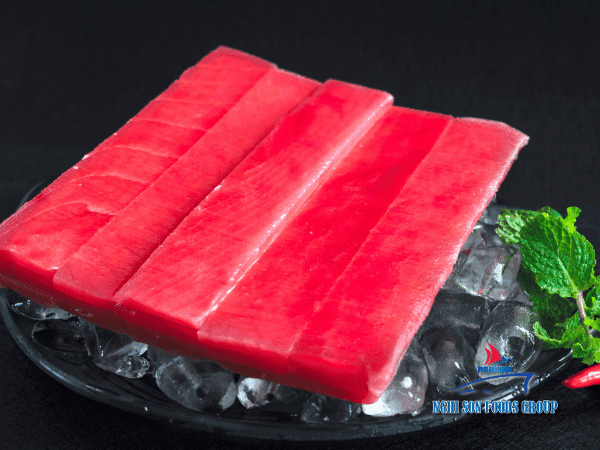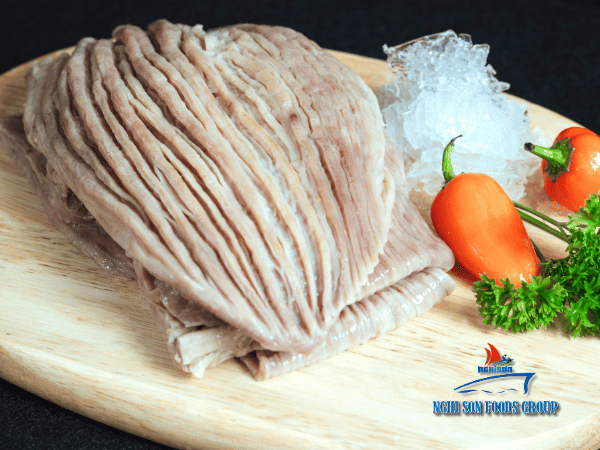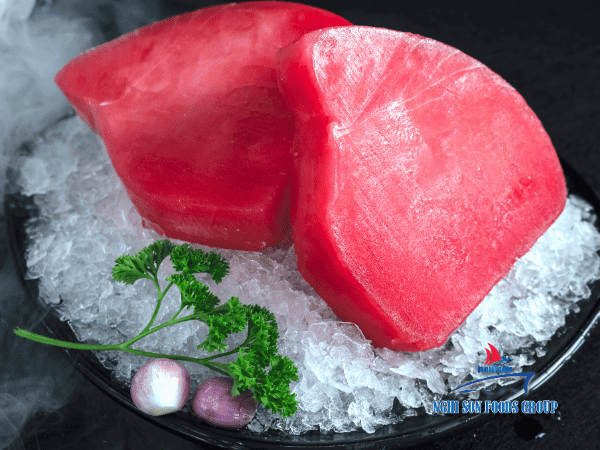Common Name: Yellowfin Tuna
Scientific Name: Thunnus albacares
Market Name(s): Ahi
Table of Contents
ToggleSeafood Profile
Sourcing Summary
Yellowfin tuna, scientifically known as Thunnus albacares, is one of the most sought-after fish species globally. It’s available in a variety of forms including fresh, frozen, and canned. Canned yellowfin, often marketed as “light” tuna, possesses a slightly darker hue compared to albacore. When it comes to quality, the U.S. market typically finds Number 2 quality acceptable, whereas Number 1 quality is predominantly exported to Japan. Fresh and frozen yellowfin are usually sold in loins and steaks. For those looking for the best quality, early fall is the optimal time to purchase fresh yellowfin. In cases of frozen yellowfin, a treatment involving carbon monoxide or a tasteless smoke is applied to preserve the vibrant red color. However, it’s worth noting that fresh yellowfin loins and steaks are seldom subjected to carbon monoxide treatment to maintain their natural color.
Harvest Methods
Yellow fin tuna is harvested through various methods, each with its unique approach:
- Troll: A method involving trailing a baited line behind a moving boat.
- Purse Seine: This method uses a large net to encircle a school of fish.
- Pole: Fishermen use a single fishing line with bait, targeting specific fish.
- Longline: Involves deploying a long line with numerous baited hooks.
Product Forms
Yellowfin tuna is available in a range of product forms, catering to diverse culinary preferences:
- Fresh: Offered in Chunks, H&G (Head and Gut), Loins, Portions, and Steaks.
- Frozen: Available in H&G, Loins, Portions, and Steaks.
Fresh Seasonal Availability
To make the most of fresh yellowfin, consider purchasing during the months of June, July, August, and September.
Culinary Composition
Understanding the flavor, texture, and oil content of yellow fin tuna aids in crafting delectable dishes:
- Flavor: Mild, making it versatile for various culinary applications.
- Texture: Firm, providing a satisfying mouthfeel.
- Oil: Low, contributing to a lean and healthy protein source.
Health & Nutrition
Yellowfin tuna is a powerhouse of essential nutrients. To reap its benefits, consider the recommended servings per month:
| Men | 3 servings |
| Women | 4 servings |
| Kids (6-12) | 2 servings |
| Kids (0-5) | 1 serving |
>> See more: Table of nutritional value of yellowfin tuna
Cooking Methods
Versatility is one of yellow fin tuna’s key attributes. It can be prepared using an array of cooking techniques, including baking, broiling, grilling, sautéing, and smoking. This versatility makes it a favorite among chefs and home cooks alike.
Advisory Concern
While yellowfin tuna is generally considered a safe seafood choice, it’s advisable to stay informed about any advisories or recommendations regarding consumption. Staying updated ensures that you make choices aligned with health and sustainability.
Biology & Habitat
Biology
Understanding the biological characteristics of yellow fin tuna sheds light on its unique adaptations and life cycle. Notable features include a distinctive bright yellow dorsal fin and a yellow stripe along its body. In comparison to its counterparts, yellowfin tuna boast a slender physique, allowing them to achieve remarkable speeds of up to 50 miles per hour. This agility stems from a combination of factors, including an enlarged heart, increased blood circulation, and higher blood pressure. These physiological traits enable them to sustain rapid speeds over extended distances.
Yellow fin tuna exhibit remarkable adaptability to varying environments. By tucking their fins into specialized grooves, they streamline their bodies for enhanced speed. Additionally, their circulatory system employs a counter-current heat exchange mechanism, ensuring optimal body temperature regulation even in colder, oxygen-depleted waters.
In terms of growth, yellowfin tuna are swift developers, capable of attaining lengths of up to seven feet and weighing as much as 400 pounds. However, the average catch typically ranges around 80 pounds. With a relatively brief lifespan of approximately seven years, they reach maturity between two and three years of age, measuring around three feet in length. Reproduction occurs year-round, with a peak during summer, contingent upon favorable environmental conditions such as water temperature and food availability. Females exhibit prolific spawning, producing an average of one to four million eggs per cycle.
Species Habitat
Yellow fin tuna are classified as pelagic and oceanic species, signifying their penchant for open waters and extensive migrations. Their range spans the subtropical and tropical zones of the Atlantic, Indian, and Pacific Oceans. In the eastern Pacific, they predominantly occur from southern California and the Gulf of California to Peru, encompassing numerous oceanic islands. Yellowfin tuna exhibit sensitivity to low oxygen concentrations, typically avoiding depths below 820 feet (250 meters) in tropical regions. They thrive in waters ranging from 65℉ to 88℉ (18-31°C). Their distribution is influenced by seasonal and temperature-driven shifts, with larval stages predominantly found in warm surface waters.
Schooling behavior is prominent in yellow fin tuna, particularly in near-surface waters. Juveniles often form schools alongside skipjack and young bigeye tuna. Adult populations coalesce into schools of similarly sized individuals, with both free-swimming and associated groupings observed. Some schools even associate with floating debris and marine fauna, exemplifying their dynamic ecological interactions.
Science & Management
Wild
Scientific research plays a pivotal role in comprehending the intricacies of yellowfin tuna populations. Collaborative initiatives, such as the Atlantic Ocean Tropical Tuna Tagging Programme (AOTTP) and the Pacific Tuna Tagging Project (PTTP), contribute essential data regarding stock dynamics, migration patterns, and habitat utilization.
Environmental shifts, particularly the expansion of hypoxic zones, impact both yellow fin tuna habitats and fishing patterns. The escalation in fish aggregating device (FAD) utilization has reshaped catch compositions, exerting a cascading effect on the broader ecosystem.
Management
The conservation and sustainable management of yellowfin tuna are entrusted to diverse fishery management organizations, including ICCAT, IATTC, IOTC, and WCPFC. These bodies implement an array of measures designed to safeguard against over-exploitation. Notable interventions include catch limits, restrictions on FAD deployment, and comprehensive reporting mandates for vessels.
Despite proactive endeavors to manage yellow fin tuna, persistent challenges persist. These encompass the reduction of bycatch and the need to address the repercussions of environmental perturbations on their habitats.
Impact on Stock
Habitat Impacts
Yellowfin tuna are predominantly harvested using techniques that yield minimal impacts on ocean habitats. However, the use of anchored fish aggregating devices (FADs) introduces a potential source of contact. The pelagic longlines, trolling, and pole fishing methods adopted in yellow fin tuna harvesting present a low risk to seabed habitats, according to assessments by Seafood Watch.
Bycatch
Bycatch in yellowfin tuna fisheries can be substantial, particularly when FADs are deployed. Bycatch includes a diverse range of species, encompassing threatened and endangered marine mammals, dolphins, sea turtles, sharks, other tuna species, marlin, manta rays, wahoo, stingrays, and juvenile tunas. The issue is exacerbated with the utilization of FADs. Noteworthy efforts have been made to mitigate bycatch, such as releasing dolphins from purse seine nets. These efforts have yielded improvements, yet challenges persist, and some populations are yet to recover fully.
Management Effectiveness
The effectiveness of yellow fin tuna management varies across regions and organizations. While some management measures have been rated moderately effective, others, especially those pertaining to bycatch and FAD deployment, are considered ineffective or suboptimal in specific areas. Continued efforts aim to enhance monitoring practices and promote sustainable harvesting practices.
Sustainable Practices & Certifications
Sustainable Fishing Practices
Sustainability is a paramount concern when purchasing yellowfin tuna. To support responsible fishing practices and make eco-conscious choices, consider the following aspects:
- Fishing Methods: Opt for yellow fin tuna caught using methods with lower environmental impact, such as pole and line or troll fishing. These methods typically result in reduced bycatch and habitat disruption.
- Certifications: Look for certifications from reputable organizations like the Marine Stewardship Council (MSC) or the Aquaculture Stewardship Council (ASC). These certifications validate that the product adheres to sustainability standards.
- Catch Location: Be aware of the geographical origin of the yellowfin tuna. Fisheries from certain regions may have better management practices in place, leading to more sustainable catches.
Certifications to Look For
When purchasing yellow fin tuna, keep an eye out for the following certifications, which indicate that the product aligns with sustainable and responsible fishing practices:
- Marine Stewardship Council (MSC): Products bearing the MSC label have been sourced from fisheries that meet rigorous sustainability standards. The MSC certification assures consumers that the seafood is traceable and environmentally responsible.
- Aquaculture Stewardship Council (ASC): While yellowfin tuna is primarily wild-caught, some forms of aquaculture may be available. ASC certification is a reliable indicator of responsible aquaculture practices, ensuring minimal environmental impact.
- Dolphin Safe: If you’re concerned about dolphin bycatch, look for products labeled as “Dolphin Safe.” These products are sourced using methods that minimize harm to dolphins and other marine life.
Cooking and Recipe Ideas
Cooking Yellow fin Tuna
Yellowfin tuna’s versatility makes it a delightful ingredient for a wide range of dishes. Here are some popular cooking methods and recipe ideas to inspire your culinary adventures:
1. Grilled Yellow fin Tuna Steaks:
- Season tuna steaks with salt, pepper, and your favorite herbs and spices.
- Preheat the grill to high heat.
- Grill the steaks for 2-3 minutes on each side for rare to medium-rare, or longer if you prefer them well-done.
- Serve with a fresh salad or a side of grilled vegetables.
2. Poke Bowl:
- Cube fresh yellowfin tuna into bite-sized pieces.
- Toss with a mixture of soy sauce, sesame oil, green onions, and sesame seeds.
- Serve the tuna on a bed of sushi rice and top with avocado, cucumber, and pickled ginger.
3. Sushi or Sashimi:
- For sushi, roll the tuna into sushi rice and seaweed sheets.
- For sashimi, thinly slice the tuna and serve with soy sauce and wasabi.
4. Yellowfin Tuna Tacos:
- Grill or sear yellowfin tuna and slice it into thin strips.
- Fill soft taco shells with the tuna, shredded lettuce, diced tomatoes, and a drizzle of spicy mayo.
5. Yellowfin Tuna Ceviche:
- Cube yellowfin tuna and marinate it in lime juice, diced onions, cilantro, and jalapeños.
- Let it sit in the refrigerator for an hour to “cook” in the acidic lime juice.
Conclusion
Purchasing yellowfin tuna involves considering various factors, from sourcing and sustainability to cooking techniques and recipes. By prioritizing sustainable practices, choosing certified products, and exploring diverse culinary options, you can enjoy this delectable seafood while contributing to the conservation of marine ecosystems. Remember that staying informed and making responsible choices can make a significant difference in the preservation of yellowfin tuna populations for future generations to enjoy.


